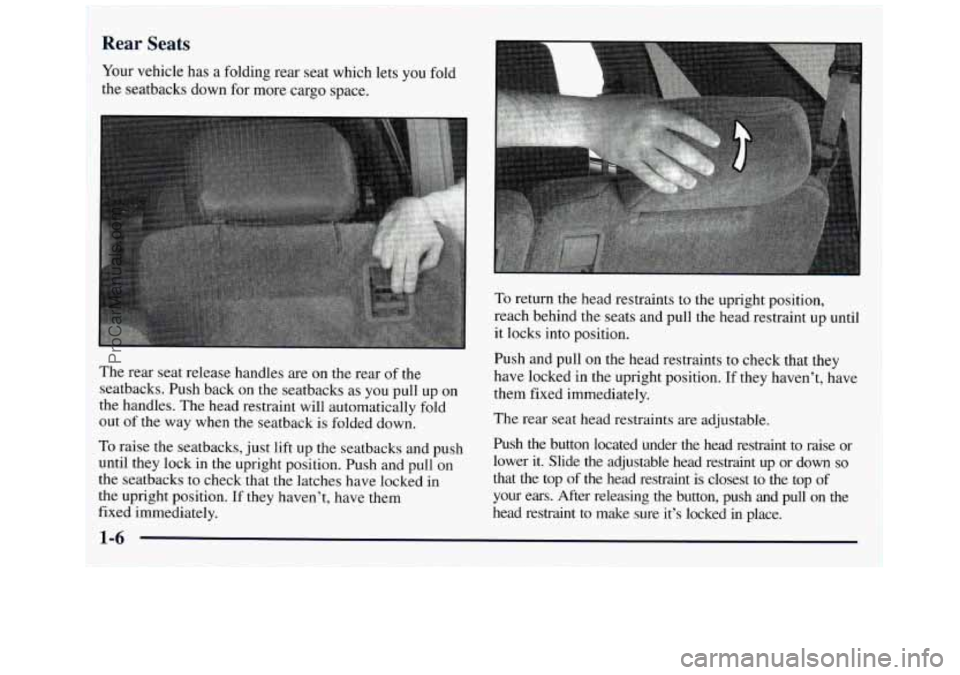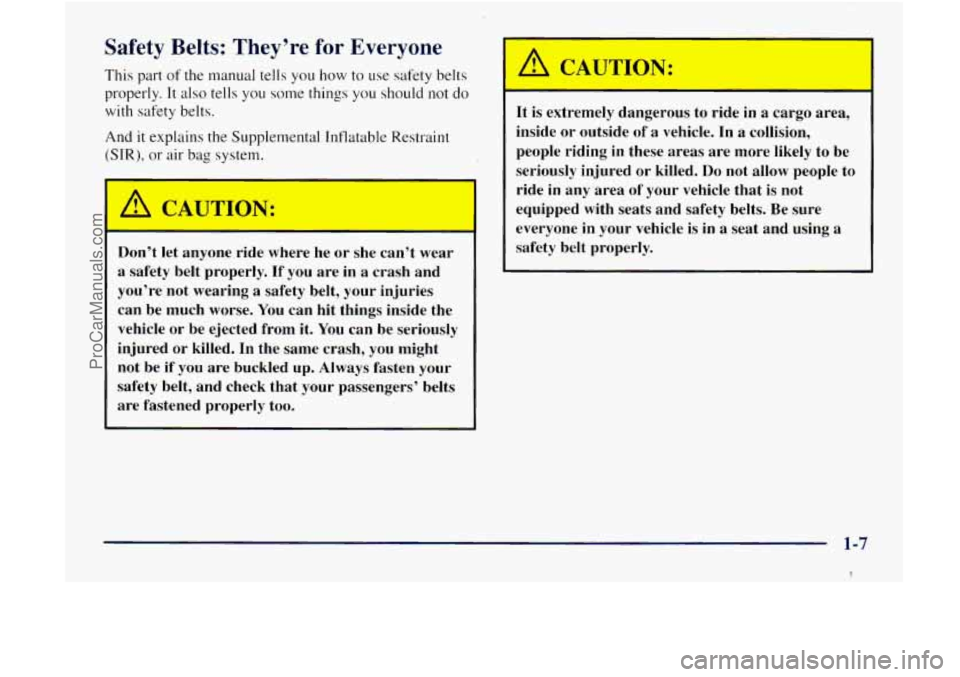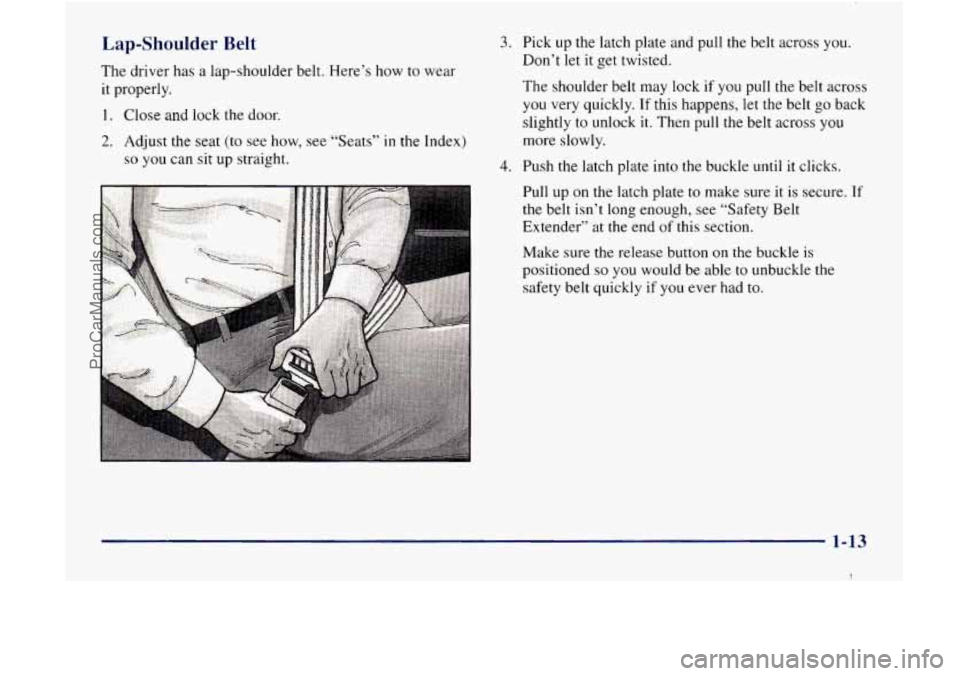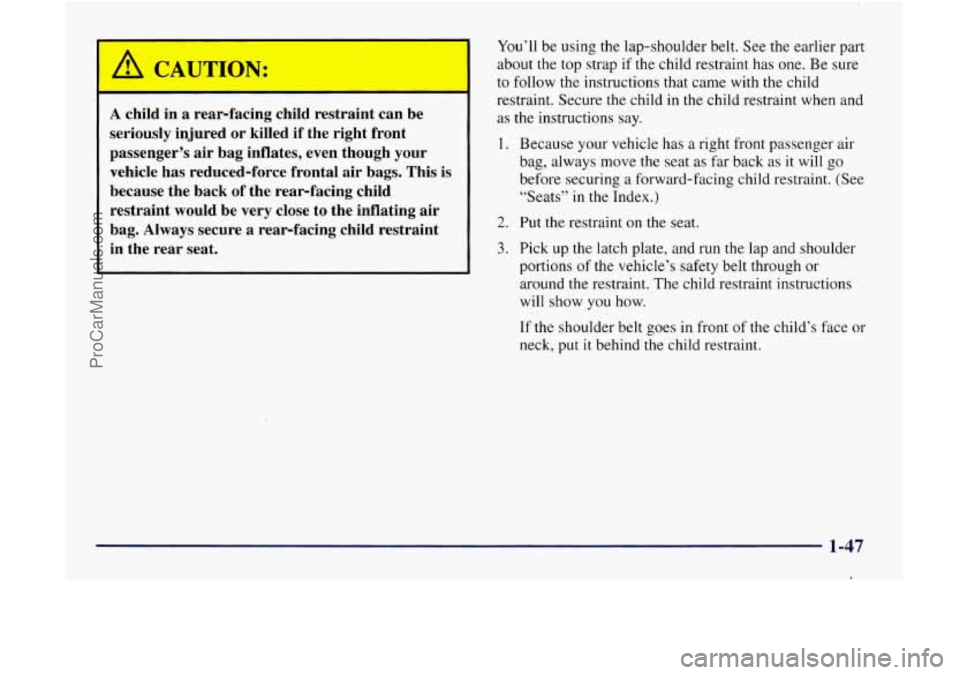seats GMC ENVOY 1998 Owners Manual
[x] Cancel search | Manufacturer: GMC, Model Year: 1998, Model line: ENVOY, Model: GMC ENVOY 1998Pages: 386, PDF Size: 20.33 MB
Page 2 of 386

The 1998 GMC Envoy Owner’s Manual
1-1
2- 1
3- 1
4- 1
5- 1
6-1
7- 1
8- 1
9-1
Seats and Restraint Systems
This section tells you how to use your seats and safe.ty belts properly. It also explains the “SIR” system.
Features and Controls
This section explains how to start and operate your vehicle.
Comfort Controls and Audio Systems
This section tells you how to adjust the ventilation and comf‘orr controls and how to operate your audio system.
Your Driving and the Road
Here you’ll find helpful information and tips about. the road and how to drive under different conditions.
Problems on the Road
This section tells what to do if you have a problem while driving, such as a flat tire or overheated engine, etc.
Service and Appearance Care
Here the manual tells you how to keep your vehicle running properly and looking good.
Maintenance Schedule
This section tells you when to perform vehicle maintenance and what fluids and lubricants to use.
Customer Assistance Information
This section tells you how to contact GMC for assistance and how to get service and owner publications.
It also gives you information on “Reporting Safety Defects” on page 8- 10.
Index
Heree‘s an alphabetical listing of almost every subject in this manual. You can use it to quickly find
something you want to read.
i
I
ProCarManuals.com
Page 8 of 386

Section 1 Seats and Restraint Systems
Here you’ll find information about the seats in your vehicle and how to use your safety belts properly. You can also
learn about some things you should nut do with air bags and safety belts.
1-2
1-7
1-11
1-12
1-12
1-19
1-20 1-20
1-28 Seats
and Seat Controls
Safety Belts: They’re for Everyone
Here Are Questions
Many People Ask About
Safety Belts
-- and the Answers
How to Wear Safety Belts Properly
Driver Position
Safety Belt Use During Pregnancy
Right Front Passenger Position
Supplemental Inflatable Restraint
(SIR) System
Rear Seat Passengers 1-3
1
1-34
1-35
1-38
1-49
1-52 1-52
1-53
Rear Safety Belt Comfort Guides for Children
and Small Adults
Center Rear Passenger Position
Children Child Restraints
Larger Children
Safety Belt Extender
Checking Your Restraint Systems
Replacing Restraint System Parts After
a Crash
1-1
ProCarManuals.com
Page 9 of 386

Seats and Seat Controls
This section tells you about the seats -- how to adjust
them, and fold them
up and down.
Power Driver’s Seat
Manual Passenger’s Seat
Move the lever under the front of the passenger’s seat up
to unlock
it. Slide the seat to where you want it. Then
release the lever and try to move the seat with your body
to make sure the seat is locked into place.
Horizontal Control: Raise the front of the seat by
raising the forward edge of the button. Lower the front
of the seat by lowering the forward edge of the button.
Move the seat forward by moving the whole button
toward the front
of the vehicle.
Raise the rear of the seat by raising the rear edge of the
button. Lower the rear of the seat
by lowering the rear
edge of the button. Move the seat rearward by moving
the whole button toward the rear of the vehicle.
1-2
ProCarManuals.com
Page 10 of 386

Moving the whole button up or down raises or lowers
the whole seat. Heated Front Seats
Vertical Control: Move the reclining front seatback
rearward by moving the button toward the rear
of the
vehicle. Move the seatback forward by moving the
button toward the front of
the vehicle.
Power Lumbar Control
This control is located on
the side
of the seat. This
feature
will quickly heat the
lower cushion and lower
back of the driver and
front passenger seats for
added comfort.
This control is located on
the side of the seat facing
the door.
Press the lower part
of the switch to turn the heater on
low. Press
the upper part of the switch to turn the heater
on high. Put
the switch in the center position to turn
the heater off. The seatbelt must be latched to activate
this feature.
Press and hold the front
of the control until you have the
desired lumbar support.
To decrease lumbar support,
press and hold the rear
of the control.
1-3
I
ProCarManuals.com
Page 13 of 386

Rear Seats I
Your vehicle has a folding rear seat which lets you fold
the seatbacks down for more cargo space.
The rear seat release handles are on the rear of the
seatbacks. Push back on the seatbacks as you pull up on
the handles. The head restraint will automatically fold
out
of the way when the seatback is folded down.
To raise the seatbacks, just lift up the seatbacks and push
until they lock in the upright position. Push and pull on
the seatbacks to check that the latches have locked in
the upright position.
If they haven’t, have them
fixed immediately. To
return the head restraints to the upright position,
reach behind the seats and pull the head restraint up until
it locks into position.
Push and pull on the head restraints to check that they
have locked in the upright position. If they haven’t, have
them fixed immediately.
The rear seat head restraints are adjustable.
Push the button located under the head restraint to raise or
lower it. Slide the adjustable head restraint up or down
so
that the top of the head restraint is closest to the top of
your ears. After releasing the button, push
and pull on the
head restraint to make sure it’s locked
in place.
1-6
I U
ProCarManuals.com
Page 14 of 386

Safety Belts: They’re for Everyone
This part of the manual tells you how to use safety belts
properly.
It also tells you some things you should not do
with safety belts.
And it explains the Supplemental Inflatable Restraint
(SIR), or air bag system.
A CAUTION:
Don’t let anyone ride where he or she can’t wear
a safety belt properly. If you are in a crash and
you’re not wearing a safety belt, your injuries
can be much worse. You can hit things inside the
vehicle or be ejected from it. You can be seriously
injured or killed.
In the same crash, you might
not be if you are buckled up. Always fasten your
safety belt, and check that your passengers’ belts
are fastened properly too.
A CAUTION:
It is extremely dangerous to ride in a cargo area,
inside or outside of a vehicle. In a collision,
people riding in these areas are more likely to be
seriously injured or killed.
Do not allow people to
ride
in any area of your vehicle that is not
equipped with seats and safety belts. Be sure
everyone in your vehicle is
in a seat and using a
, safety belt properly.
I
1-7
1
ProCarManuals.com
Page 20 of 386

Lap-Shoulder Belt
The driver has a lap-shoulder belt. Here’s how to wear
it properly.
1. Close and lock the door.
2. Adjust the seat (to see how, see “Seats” in the Index)
so you can sit up straight.
3. Pick up the latch plate and pull the belt across you.
Don’t let it get twisted.
The shoulder belt may lock
if you pull the belt across
you very quickly. If this happens, let the belt
go back
slightly to unlock it. Then pull the belt across
you
more slowly.
4. Push the latch plate into the buckle until it clicks.
Pull up on
the latch plate to make sure it is secure. If
the belt isn’t long enough, see “Safety Belt
Extender’’ at the end
of this section.
Make sure the release button on the buckle is
positioned
so you would be able to unbuckle the
safety belt quickly if
you ever had to.
1-13
ProCarManuals.com
Page 46 of 386

A rear-facing infant restraint (B) positions an infant
to face the rear of the vehicle. Rear-facing infant
restraints are designed for infants
of up to about
20 lbs. (9 kg) and about one year of age. This type
of restraint faces the rear
so that the infant’s head,
neck and body can have the support
they need in a
crash. Some infant seats come
in two parts -- the
base stays secured in the vehicle and the seat part
is removable.
.. -7 .. ,. ..I
: .. ., . 8.
1-39
ProCarManuals.com
Page 48 of 386

A booster seat (F, G) is designed for children who
are about
40 to 60 lbs. (1 8 to 27 kg) and about four
to eight years of age. It’s designed to improve the
fit of the vehicle’s safety belt system. Booster seats
with shields use lap-only belts; however, booster
seats without shields use lap-shoulder belts.
Booster seats can also help a child to see out the window.
1-41
ProCarManuals.com
Page 54 of 386

A CAULON:
A child in a rear-facing child restraint can be
seriously injured or killed
if the right front
passenger’s air bag inflates, even though your
vehicle has reduced-force frontal air bags. This
is
because the back of the rear-facing child
restraint would be very close to the inflating air
bag. Always secure a rear-facing child restraint
in the rear seat.
You’ll be using the lap-shoulder belt. See the earlier part
about the top strap if the child restraint has one. Be sure
to follow the instructions that came with the child
restraint. Secure
the child in the child restraint when and
as the instructions say.
1.
2.
3.
Because your vehicle has a right front passenger air
bag, always move the seat as far back as it will
go
before securing a forward-facing child restraint. (See
“Seats” in the Index.)
Put the restraint on the seat.
Pick up the latch plate,
and run the lap and shoulder
portions
of the vehicle’s safety belt through or
around the restraint. The child restraint instructions
will show you how.
If the shoulder belt goes in front of the child’s face or
neck, put it behind the child restraint.
1-47
I
ProCarManuals.com